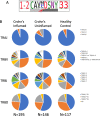Colonic mucosal associated invariant T cells in Crohn's disease have a diverse and non-public T cell receptor beta chain repertoire
- PMID: 37922286
- PMCID: PMC10624325
- DOI: 10.1371/journal.pone.0285918
Colonic mucosal associated invariant T cells in Crohn's disease have a diverse and non-public T cell receptor beta chain repertoire
Abstract
Objectives: Mucosal-Associated Invariant T (MAIT) cells are T cells with a semi-invariant T cell receptor (TCR), recognizing riboflavin precursors presented by a non-polymorphic MR1 molecule. As these precursors are produced by the gut microbiome, we characterized the frequency, phenotype and clonality of MAIT cells in human colons with and without Crohn's disease (CD).
Methods: The transcriptome of MAIT cells sorted from blood and intestinal lamina propria cells from colectomy recipients were compared with other CD8+ T cells. Colon biopsies from an additional ten CD patients and ten healthy controls (HC) were analyzed by flow cytometry. TCR genes were sequenced from individual MAIT cells from these biopsies and compared with those of MAIT cells from autologous blood.
Results: MAIT cells in the blood and colon showed a transcriptome distinct from other CD8 T cells, with more expression of the IL-23 receptor. MAIT cells were enriched in the colons of CD patients, with less NKG2D in inflamed versus uninflamed segments. Regardless of disease, most MAIT cells expressed integrin α4β7 in the colon but not in the blood, where they were enriched for α4β7 expression. TCR sequencing revealed heterogeneity in the colon and blood, with few public sequences associated with cohorts.
Conclusion: MAIT cells are enriched in the colons of CD patients and disproportionately express molecules (IL-23R, integrin α4β7) targeted by CD therapeutics, to suggest a pathogenic role for them in CD. Public TCR sequences were neither common nor sufficiently restricted to a cohort to suggest protective or pathogenic antigen-specificities.
Copyright: © 2023 Konecny et al. This is an open access article distributed under the terms of the Creative Commons Attribution License, which permits unrestricted use, distribution, and reproduction in any medium, provided the original author and source are credited.
Conflict of interest statement
The authors have declared that no competing interests exist.
Figures






References
-
- Billerbeck E, Kang YH, Walker L, Lockstone H, Grafmueller S, Fleming V, et al.. Analysis of CD161 expression on human CD8+ T cells defines a distinct functional subset with tissue-homing properties. Proc Natl Acad Sci U S A. 2010;107(7):3006–11. Epub 2010/02/06. doi: 10.1073/pnas.0914839107 ; PubMed Central PMCID: PMC2840308. - DOI - PMC - PubMed
-
- Tilloy F, Treiner E, Park SH, Garcia C, Lemonnier F, de la Salle H, et al.. An invariant T cell receptor alpha chain defines a novel TAP-independent major histocompatibility complex class Ib-restricted alpha/beta T cell subpopulation in mammals. J Exp Med. 1999;189(12):1907–21. doi: 10.1084/jem.189.12.1907 - DOI - PMC - PubMed
-
- Porcelli S, Yockey CE, Brenner MB, Balk SP. Analysis of T cell antigen receptor (TCR) expression by human peripheral blood CD4-8- alpha/beta T cells demonstrates preferential use of several V beta genes and an invariant TCR alpha chain. J Exp Med. 1993;178(1):1–16. doi: 10.1084/jem.178.1.1 ; PubMed Central PMCID: PMC2191070. - DOI - PMC - PubMed
Publication types
MeSH terms
Substances
LinkOut - more resources
Full Text Sources
Medical
Research Materials

